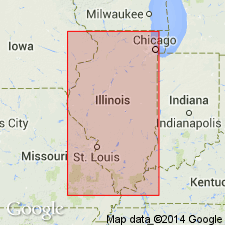
- Usage in publication:
-
- Menard formation
- Modifications:
-
- Named
- Dominant lithology:
-
- Limestone
- Shale
- AAPG geologic province:
-
- Illinois basin
Summary:
Named Menard formation. Composed of limestone and shale. Thickness is 80 ft.
Source: GNU records (USGS DDS-6; Reston GNULEX).
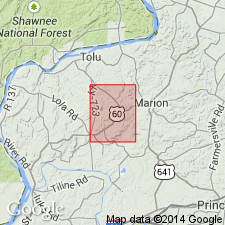
- Usage in publication:
-
- Menard Limestone*
- Modifications:
-
- Overview
- AAPG geologic province:
-
- Illinois basin
Summary:
Designated Menard Limestone in westernmost KY. Composed of finely crystalline, argillaceous limestone and calcareous, fossiliferous shale. Thickness is 130-140 ft. Underlain by Waltersburg Sandstone; overlain by Palestine Sandstone.
Source: GNU records (USGS DDS-6; Reston GNULEX).
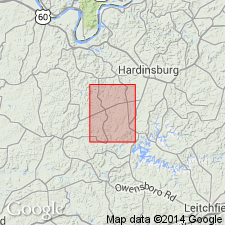
- Usage in publication:
-
- Menard Limestone Member*
- Modifications:
-
- Overview
- AAPG geologic province:
-
- Illinois basin
Summary:
Menard Limestone reduced in rank to Menard Limestone Member of Buffalo Wallow Formation in west central KY. Composed of limestone, shale, sandstone, and siltstone. As much as 70 ft thick. Underlain by Waltersburg Member and overlain by upper part of Buffalo Wallow except where unconformably overlain by Pennsylvanian rocks.
Source: GNU records (USGS DDS-6; Reston GNULEX).
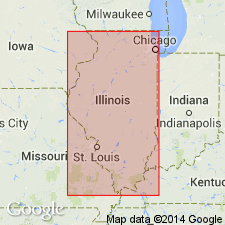
- Usage in publication:
-
- Menard Limestone
- Modifications:
-
- Overview
- AAPG geologic province:
-
- Illinois basin
Summary:
Current (1975) usage of the Illinois Geological Survey is Menard Limestone. A limestone and shale formation readily divisible into three limestone members--the Walche (below), the Scottsburg, and the Allard--which are separated by unnamed shale members; a third shale occurs at the top. The limestone is argillaceous, dark brownish gray to brown and buff, dense, and fine grained to lithographic. Limestone members are more or less shaly. Occurs in southern part of Illinois; 100-150 ft thick in southern part of area of occurrence, 80-100 ft thick in central part, 45-60 ft thick in northern part. Underlain by Waltersburg Formation; overlain by Palestine Sandstone. Includes isopach map.
Source: GNU records (USGS DDS-6; Reston GNULEX).
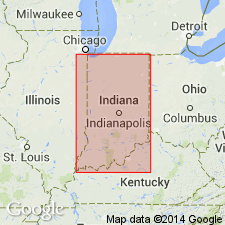
- Usage in publication:
-
- Menard Limestone
- Modifications:
-
- Overview
- AAPG geologic province:
-
- Illinois basin
Summary:
Current (1986) usage of Indiana Geological Survey is Menard Limestone of Buffalo Wallow Group. Name Menard is confined to the subsurface. Outcropping tongues of the Menard are designated the Siberia Limestone Member of the Tobinsport Formation and the Leopold Limestone Member of the Branchville Formation. "Three subunits, informally designated "upper," "massive," and "little" Menard are recognized. Where the upper Menard is recognizable, it is a limestone 10 ft (3 m) thick. The massive or main Menard consists of 30 to 60 ft (9 to 18 m) of limestone. Beneath this are 15 ft (5 m) of dark-gray shale that is not named and the little or lower Menard, which is limestone and is 8 to 10 ft (2 to 3 m) thick." Limestone is principally light gray and micritic. Overlies Waltersburg Sandstone and is overlain in most places by Palestine Sandstone. Recognized in Indiana from Dubois Co. southwestward.
Source: GNU records (USGS DDS-6; Reston GNULEX).
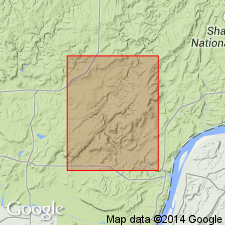
- Usage in publication:
-
- Menard Limestone
- Modifications:
-
- Revised
- AAPG geologic province:
-
- Illinois basin
Summary:
The Pope Group, here revised from Megagroup and apparently reinstated, comprises strata from the base of the Aux Vases Sandstone to the top of the Kinkaid Formation, which includes the Menard Limestone. According to authors, "The Pope Group is a lithostratigraphic unit distinct from its chronostratigraphic counterpart, the Chesterian Series." The lower boundaries of the two differ slightly. The group is about 1,425 ft thick in the Waltersburg quad, but the lowermost formations, from the Aux Vases Sandstone up to the Fraileys Shale Member of the Golconda Formation do not crop out. This interval is 384 ft thick in the Austin Roberts No. 1 Well. [See subunit list in index portion of Pope summary record. Publication does not name the units between the Aux Vases and the Fraileys and therefore these have not been included in the list.]
Source: GNU records (USGS DDS-6; Reston GNULEX).
For more information, please contact Nancy Stamm, Geologic Names Committee Secretary.
Asterisk (*) indicates published by U.S. Geological Survey authors.
"No current usage" (†) implies that a name has been abandoned or has fallen into disuse. Former usage and, if known, replacement name given in parentheses ( ).
Slash (/) indicates name conflicts with nomenclatural guidelines (CSN, 1933; ACSN, 1961, 1970; NACSN, 1983, 2005, 2021). May be explained within brackets ([ ]).

